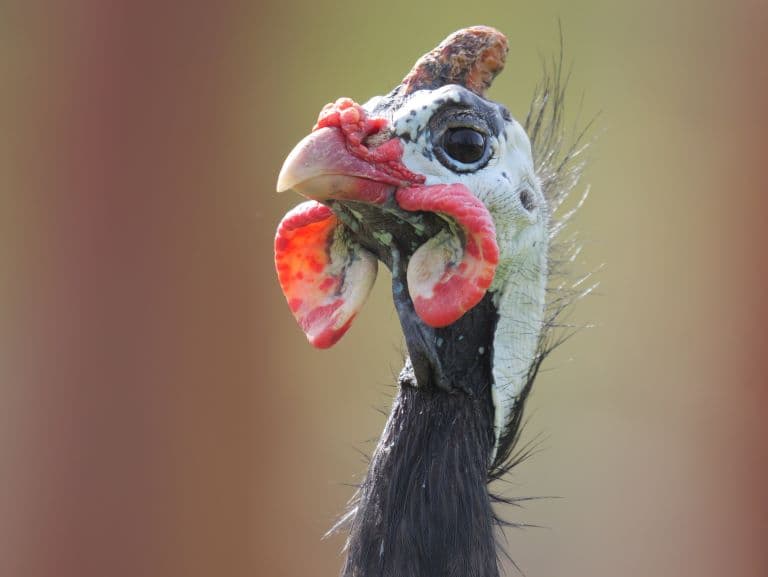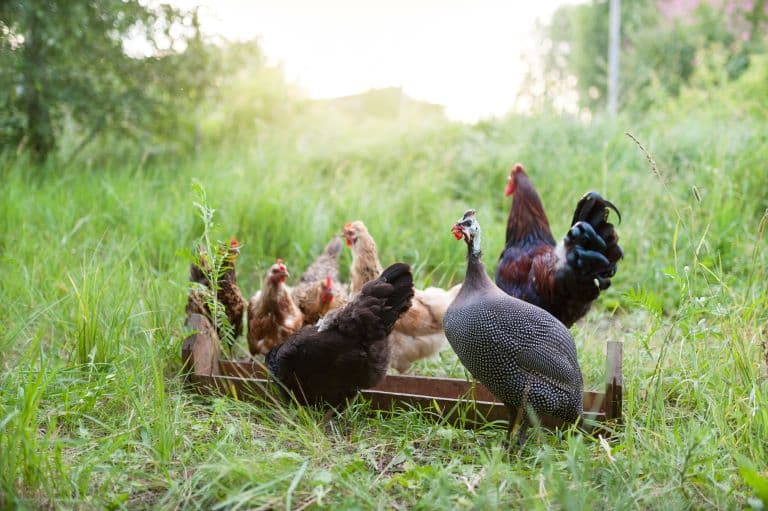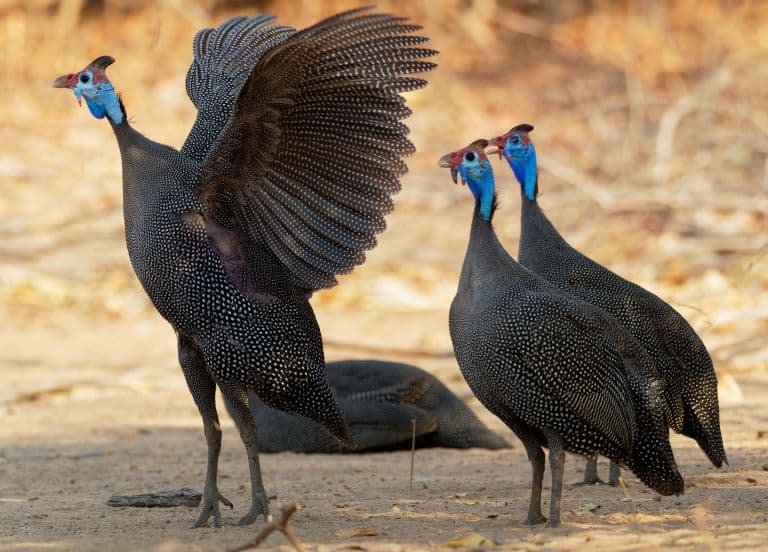Guineafowl Profile
An old Swahili tale talks about an early alliance between a cow and a bird. All day, the cow would keep watch for lions while the bird fed. In exchange, the bird would act as a decoy if ever a lion was spotted.
After diverting a lion’s attack, the cow thanked the bird by spraying it with milk, giving its dark feathers a spattering of bright white spots. This is almost certainly the true origin of the guineafowl’s pretty feathers but it doesn’t go very far to explaining why they’re so loud.

Guineafowl Facts Overview
| Habitat: | Forest, semi-open areas, savanna |
| Location: | Africa |
| Lifespan: | 15 years |
| Size: | Up to 71cm (28 in) long |
| Weight: | Up to 1.6 kg (3.5 lb) |
| Colour: | Often dark with white speckles, some have wattles or crests |
| Diet: | Varied: both animal and plant foods |
| Predators: | Leopards, wild cats, servals, civets, dogs, crocodiles |
| Top Speed: | 35 km/h (22 mph) |
| No. of Species: | 8, in 4 genera |
| Conservation Status: | Most Least Concern, white-breasted guineafowl Vulnerable (IUCN) |
Guineafowl are ancient ground birds that appear to have given rise to a lot of the more familiar species we have around today.
They’re native to Africa and make up 8 species in the Galliformes order, most are quite good-looking birds.
While they can fly, they rarely do, and are much more comfortable running at speed. These noisy birds have been domesticated too and make good early-warning systems for other, dumber animals.
Interesting Guineafowl Facts
1. They’re landfowl
The Galliformes (meaning “chicken-like”) are an order of land fowl that include the chubby ground birds such as pheasants and quails.
The order is quite diverse and widespread to every continent except Antarctica. Within the order, the familiar families are the pheasants, the New World quails, and this one: the guineafowl.
Guineafowl are most closely related to the two aforementioned families but appear to have come quite a long time before they emerged.
As they are, guineafowl resemble something between a giant quail and a very noisy turkey, yet they predate both.
2. They predate chickens
Both turkeys and chickens are probably from the same stock, and make up the Phasianidae family, along with the quails, junglefowl and partridges. They’re the sister group of the New World quails, and both of these families sit somewhere in front of the guineafowl lineage.
As such, the guineafowl are an ancient member, coming before chickens and turkeys even existed, and continuing to this day as some of the oldest groups of Galliformes around. 1

3. They can fly
Like chickens, and many others in their order, these birds can technically fly. Unlike chickens, they can fly pretty well, though even these birds prefer to run away from danger unless it’s completely necessary to take to the air.
Guineafowls can probably run faster than they can fly and have been clocked at running speeds of at least 35 km/h. 2
4. They can be very pretty
Of the eight species, many are very good-looking birds. Possibly the most appealing is the helmeted guineafowl – the heaviest species, at almost 60cm tall and weighing well over 1kg.
This bird is grey-black and speckled, and while its head is unfeathered, it makes up for it with a colourful face of blues, black, and yellow.
Likewise, the plumed guineafowls are pretty birds too, with a crest and long wattle along with a blue head, often with orange patches.
But they’re not all pretty.

5. Or pretty ugly
The vulturine guineafowl is a large species, taller than the helmeted bird, but thinner. It’s named for its unfeathered head and neck that have no redeeming features and make it look a lot like its namesake. It has red eyes, and sometimes even tufts of red ear hair covering the holes on the side of its head.
It also has long legs and a longer neck than other species, and while its plumage is still pretty cool, with blue and white stripes, it’s hard to get over that face.
6. They’ve been domesticated
It should be of no surprise that some of the better-looking species have drawn human attention, and the helmeted guineafowl has a history of domestication that spans at least 2000 years. Not only is it now bred for ornamental and egg purposes, but the meat is supposed to be quite popular, too.
They’re bred for meat, eggs, companionship and to make the place look a bit nicer, but one of the most convenient aspects of farming guinea fowl is how noisy they are. 3
7. They’re good guard animals
Being loud turkeys, these birds make a racket when they’re disturbed. This is very handy for farmers (and, presumably, legendary cows), who sometimes put them with the pheasants to act as guard animals.
Much in the same way geese can be used, but with far less of the attitude.
Guineafowl live a long time, at up to 15 years, so can make a great addition to a menagerie, as long as they’re given enough room.
But the perks don’t end at guarding. 4
8. They also help reduce disease
Helmeted guineafowl are notorious tick eaters, and as birds who are happy to gather in groups of up to 25, they can act as a sweeping form of pest control, too.
This species can walk 10 km a day, consuming massive amounts of ticks, which not only helps keep domesticated animals safe but also serves a valuable role in the wild for the same reason.
All this tick-eating helps reduce the amount of Lyme disease in their habitats significantly.
9. Some are communal layers
Some species are known to work together to lay and rear their young. Domestic breeds might lay up to 50 eggs in a single nest, with multiple mothers involved, and will take turns to incubate them.
Unfortunately, this care doesn’t extend to the chicks, who will often die as a result of the negligent, very chicken-like parenting skills of the adults.
Guineafowl Fact-File Summary
Scientific Classification
| Kingdom: | Animalia |
| Phylum: | Chordata |
| Class: | Aves |
| Order: | Galliformes |
| Family: | Numididae |
Fact Sources & References
- Brookfield Zoo Chicago (2020), “Guinea Fowl Sound the Alarm”, YouTube.
- pIants2010 (2001), “guinea fowl flight”, YouTube.
- Alain Vignal (2019), “A guinea fowl genome assembly provides new evidence on evolution following domestication and selection in galliformes”, Wiley Online Library.
- Azure Farm, “A Beginner’s Guide To Raising Guinea Fowl – The Essentials You Need to Know”, Azure Farm Life.
